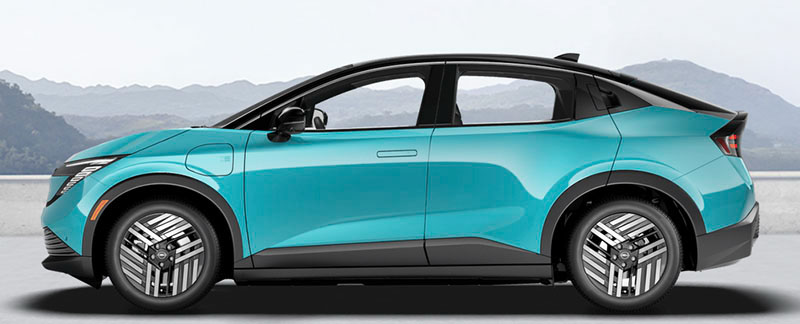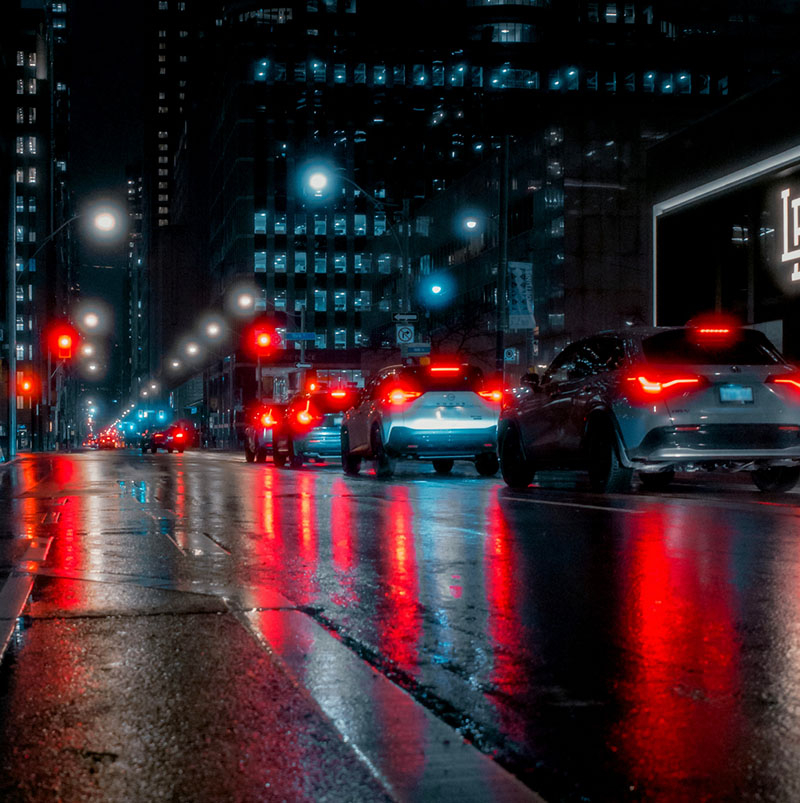[UPDATE: I done did the deed! I bought a 2023 Nissan Ariya Engage e-4orce EV with 3,700 miles on it (not a typo) for $20,995 (also not a typo) on August 1st, 2025, ten years to the day after I closed on the sale of my house in Wisconsin to move here. Super smooth, fast, comfortable car with lots of luxury touches. "Like New" in used camera terms.
Nissan (manufacturer) Ariya (model) Engage (trim tier) e-4orce (AWD). It was the sixth of the original eight trim levels in 2023, third from the bottom, one of only two trims with the smaller battery. The original price was approx. $48,190 two+ years ago. That's about a 56–57% depreciation in two years, which is...a lot for a near-luxury-level SUV with only 3,700 miles on it.
Three main reasons it was so cheap AFAIK:
- Nissan is limping globally in terms of business health
- Smaller battery + dual motors and AWD with tons of e-horsepower and torque = low range
- Slow charging, both at home (7.2 kW) and at DC Fast Chargers (130 kW)
All three of those are bad for sales, especially since charging speed and driving range are the chief concerns of new EV adopters. (That was Musk's big innovation with Tesla: give the cars great big heavy batteries to quiet consumers' range concerns.)
I bought it mainly because it was within reach for me, which almost nothing is, but there's a lot I like about it. Mainly, it has an opulent and very tasteful interior, but without the increasingly trifling overcomplications in the interiors of the highest models (I don't need a motor to open the secondary glove box, for instance). Main thing I'll touch on: it's possibly the most comfortable car I, now a sedentary overweight 6'1" 68-year-old*, have ever clambered into. The exceptionally good seats slide back automatically when you open the door to make egress and entry easier, the height and the lack of a stepover are very comfortable, and I love the elaborate "coffee table" which is what Nissan calls the center armrest. Importantly (I might even say crucially) for me, there's no center stack. The sharp side of a center stack digging into the side of my knee in a painful way is a surprisingly prevalent problem for me, disqualifying my second choice, the new Civic Hybrid.
Two pet-peevish things I love: you can cover up the cup holders, which are an eyesore in most vehicle cockpits IMO. And you lower the tailgate with your arm, which I remain convinced is something I am capable of doing all by myself like a big boy. No offense if your taste is for the opposite.
Anyway, brave new world. I'm as excited as a kid with a new toy. However, this news means you will stop hearing about EVs very shortly now, as I'll be "stopping shopping" soon. (And, as always [cheap pens?!? Really Mike?], thank you for your patience with me.) My late brother Scott's rule amongst the brothers was "new sheet metal requires pictures," but I haven't taken delivery yet. Pictures to come.
I beg your pardon for the off-topic post, but I'm just immersed in learning about EVs and everything associated with them (great fun, by the way) and I can't help but have the subject on the brain. (I have this problem: it's by far easiest to write about whatever I'm enthusiastic about at the moment. A few of you might possibly have noticed.)
Here's the thought: it's that one big problem with EVs resides, collectively, in our own heads. We need to re-train ourselves to think differently about fueling.
For years—forever—we have learned, practiced, and internalized the liquid-fueling protocol, namely, drive till empty and then fuel completely all at once, while on the move—that is, as a stop in the midst of driving around or driving toward a destination. So far, everybody except EV adopters still wants to mentally shoehorn electric cars into the liquid-fueling model—drive till almost empty then fuel all at once en route, while out driving. Well, not to sound like a second-grader, but that's not fair. At some point we'll have to change that thinking. Electric refueling goes like this: top off if needed when the vehicle is at rest, meaning mostly at home. It's a new way of thinking about fueling, with a new set of plusses and minuses. So by assuming or insisting that electric cars must replicate the paradigm of liquid refueling above all else, people are naturally allowing their thinking about EVs to be distorted. They have mental blinders on, so to speak. Mental blinders of their own making. Because, obviously, electric refueling is not going to be equally good at the one thing that liquid refueling is best at.
That's what creates "range anxiety"—because we're thinking about driving till empty. And we're assuming we'll need to charge on the road. And all of us (or maybe I should speak for myself) are familiar with that panicky feeling of suddenly realizing the gas gauge is low. Or of actually running out of gas and becoming stranded. But from most of the EV owners I've heard from, they don't drive till empty. That's not how the new model works. They let the charge go down as it will or as it must and then charge it back up more or less right away, the next time the car is at rest and not being used.
I first encountered this idea about fueling and peoples' thinking about it in an article written by Adrian Salinas at an Australian site called ArenaWire.
For most non-city-dwelling drivers (I didn't say all, and yes, I know the exceptions are out there), the car sits idle for most of most days, and even more of the nights. That's certainly true of what I would call "commuter" driving, meaning [home —> work or errands —> home]. Put it this way—imagine you had your own gas pump right next to your garage and the gas in it was nearly free. How many times would you come home at night running on fumes? If you said anything but "never," you're an edge case (maybe you work as a rural mailman. Maybe you have a 170-mile commute each way). If [home —> distant destination] driving is electric fueling's worst thing, then its best thing is that suddenly you do have a gas station in your own garage, with fuel that costs 1/3rd to 1/5th of what liquid fuel costs. Commuter driving is electric's best end-user attribute. Gas/petrol can't touch it.
To figure out if it's for you, all you have to figure out is, how much of your driving leaves the car resting at home, and what's your longest possible daily commuter trip? For me it's a drive to Rochester + maybe 35 extra miles at most doing other things along the way or afterward. That's 150 miles round trip give or take. That's my outlier. Well within the range of all but one or two of the worst EVs still on the market. And 98% if not 99% of my driving is commuter driving, starting and ending at home. For that last 2% or 1%, I could either deal with charging along the way, or rent a car.
The new 2026 Nissan Leaf, coming this Fall
A funny little aside: I have a friend here who bemoans range anxiety with great drama. At which point I remind him that he's got four cars. What, can't he just snag the keys to the ICE SUV on the way out the door for that road trip? Having a liquid-fuel vehicle as well as an EV is the crude way to quiet range anxiety. Any given person might not want this, and it makes no sense to prescribe it, but then, it's also true that a lot of people have it. Hedges & Company estimates that approximately 37% of US households own two cars, and an additional 22% own three or more cars (via AI overview). I've got a friend who has one "good" (expensive, shiny, new) and one "beater" (worn, working, older) pickup truck, as well as a motley of several lesser cars...and a 4-wheeler, and an enormous motor-scooter he bought for a departed girlfriend, and two real motorcycles, and so on. I don't know his opinion about electric cars, but I'll try to remember to tread gently and not blast him a new one if has the temerity to bring up range anxiety as the "deal killer" with Yr. Hmbl. Ed.
Finally, not meaning to be incendiary, but...Eisenhower built the entire Interstate highway system. Surely our flattened, infiltrated version of the once-mighty Federal government, meek, meagre and withered as it has become, could eventually shift itself to install EV chargers all along those highways. That would take care of a whole lot of those long-range trips. We even have convenient places already reserved to put them...they're called rest stops.
Mike
*I used to be 6'2", no kidding.
P.S. Here's a nice video about what it actually costs to run an EV.
Original contents copyright 2025 by Michael C. Johnston and/or the bylined author. All Rights Reserved. Links in this post may be to our affiliates; sales through affiliate links may benefit this site. As an Amazon Associate I earn from qualifying purchases. (To see all the comments, click on the "Comments" link below or on the title of this post.)
Featured Comments from:


























